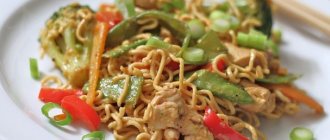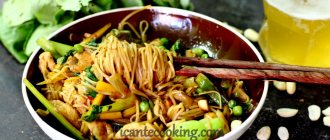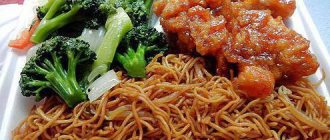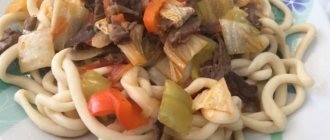What a delicious soup with homemade noodles, it’s simply delicious! You probably won’t find a person who would say that he doesn’t like this dish. The rich broth with chicken and homemade noodles is simply delicious.
However, and unfortunately, not everyone can make homemade noodles - some people can’t make the dough, others the noodles are overcooked. But not everything is so bad, you can learn everything, we suggest you consider recipes: how to properly prepare noodles and soups with it.
A few cooking rules:
- Flour must have a high gluten content. Pay attention to the amount of protein in the flour.
- The kneaded dough should not stick to your hands. Proper kneading produces a tight, dense lump.
- The flour must be sifted.
- After kneading, you need to let the dough “rest” in the refrigerator, wrapping it in film or covering the bowl with a lid.
- To easily dry the noodles on eggs, you need to take several linen kitchen towels or pieces of cotton fabric. Select a drying location in advance.
Classic recipe with photos step by step.
Let's look at an example using one or two medium-sized eggs. This is enough to prepare a large portion of soup for 5-6 people. If you are making preparations or you have a family of homemade noodle lovers, then increase the amount of products proportionally.
Just keep in mind that making it for future use requires a lot of space for drying and storage. You can’t pack such noodles tightly into a jar; the noodles will break when removed. But for storage you can use linen bags, large glass jars or bags.
To prepare, take:
- one - two chicken eggs;
- 100-120 grams of premium flour;
- ½ tsp. fine salt.
Pour the flour into a deep bowl, sifting it along with the salt. Make a well in the mound and pour in the egg. I prefer to first beat the egg a little with a fork until smooth in a separate bowl. This will make kneading the dough easier. First, use a fork and then use your hands to knead the mixture until it becomes pliable and easily comes off your hands. You may need to add more flour.
When the lump reaches the desired consistency—it becomes dense and you can pinch off soft pieces—continue kneading for another minute or two. Any dough “loves” your hands, and this one especially. Now wrap the lump in cling film and leave it in the refrigerator for an hour. If you don't cover the dough, it will dry out and the noodle strips won't have a uniform texture.
After rising, we begin the cutting process. On a large board or directly on the table with a rolling pin, roll out the layer. It is very important that it turns out thin (one, maximum two millimeters) and evenly rolled out.
Sprinkle flour on top and begin rolling into a loose roll. It is better to cut off uneven edges. Now carefully and with clear movements using a sharp knife, cut strips about 5 mm wide.
There are two options for drying noodles:
- rolled up;
- straight stripes.
The first option is much easier to dry and store. But the noodles turn out to be long. By unrolling the skein, you can cut strips of the required length. If you want to cut a “cobweb”, you should initially cut the roll into wide strips (about 1 cm). It remains to cut a transverse straw 2-3 mm wide. This type of pasta is very easy to store and cooks faster.
Leave the raw noodles to dry on towels for about 6-10 hours. The time depends on air humidity, temperature in the house and the presence of a draft. Shake the noodles periodically to prevent sticking. Then, after drying, carefully place it in a bag or jar. Homemade noodles should be cooked a little less than store-bought ones.
Homemade noodles - dough recipe and preparation
Every housewife should try a homemade noodle recipe at least once in her life in order to have an idea of a real soulful meal made with her own hands.
Many people prefer not to bother making homemade noodles at home. Of course, store shelves offer so many different varieties of small pasta to choose from that sometimes you just don’t think that it would be nice to make homemade noodles yourself.
It’s much faster and easier to throw a pinch or two ready from the bag.
- But homemade noodles are much more soulful, they retain the love and warmth of our hands, and like any handmade product, they are valued much higher than crispy bags from industrial lines of Italian origin...
- But you only need a little, a handful of flour, an egg and a pinch of salt... And the true magic begins...
- Once you have tasted such noodles, kneaded and rolled out by hand, you will not forget the taste and comfort of this lunch!
- Usually homemade noodles are prepared by boiling aromatic chicken broth in the house, because with it the noodles will be especially tasty.
- Do not skimp on chicken bones, roots and seasonings, cut fresh noodles and there will be a real feast of taste in the house! No broth? It doesn’t matter either, you can cook wonderful noodles in water, adding an onion fried with brisket, putting half an egg in each plate and sprinkling with herbs... If only there were noodles, a delicious lunch would definitely come with it. Have you decided? Well, then let's get to work! Now I will tell you and show you how to cook homemade noodles.
Number of servings: 4-5 people.
This is the basic recipe. If you want noodles that are more elastic and smooth, then add 1 tablespoon of olive oil to the dough. If you want to experiment with color, you can make colored noodles.
Green noodles will be with parsley juice, orange with turmeric or saffron.
You can experiment with your favorite spices, with your favorite additives ad infinitum; there can be many dough options here!
To work at this stage you will need a bowl and fork.
So, break an egg into a bowl, add salt and beat a little with a fork until the white, yolk and salt are mixed. Without fanaticism. And not to the point of foam.
If herbs, spices or colors are added to the dough, this is done at this stage so that the noodles are evenly colored.
If you want speckled noodles with herbs, for example, then it is better to mix it with some flour and then rub the dough on the table with this mixture.
Add flour to the egg in small portions and knead with a fork each time until smooth, there should be no lumps in the dough. Add flour until it comes together in one lump and pulls away from the sides of the bowl.
Dust the work surface (table) with flour and place the dough from the bowl on it. Rub the dough with flour on the table until the dough becomes elastic, will lag behind your hands, but will remain soft enough.
It is important not to overload the dough with flour, add it in small portions.
Then divide the resulting dough into 4 parts, roll them into balls, cover with film and let rest a little.
At this time, you need to prepare the following necessary tools for rolling and cutting.
- It will take a little more flour. You can take wheat flour, or you can take corn flour; for beginners in cutting noodles, this can even help, because the grind of corn flour is coarser and it is not so quickly absorbed by the moisture of the dough.
- You will also need, in fact, a rolling pin, a sharp knife and a cutting board. You also need to take care of the surface on which the noodles will dry. This can be a large cutting board, a tray, or just part of the desktop if there is enough space.
- To roll out the noodles, take a piece of dough from under the film, dust it, as well as the table, with flour, start rolling in two directions, adding flour to the rolling and turning the dough so that the workpiece is evenly and as thin as possible.
- When rolling, the dough can be folded and unfolded for greater convenience, but the seams from folding must then always be rolled out so that there are no creases in the dough. Cut the workpiece with a sharp knife into strips of the desired width, or not cut at all if you need long noodles. Fold and twist the dough piece into an elastic and fairly dense scroll.
On a cutting board, cut the noodles to the desired width, holding the knife at a slight angle from the top and sides. This will make the noodles more beautiful and easier to cut.
Use your hands to “fluff” the cut-out scrolls to a “lace” state and place them on a designated surface to dry. Repeat the rolling and cutting operation with the remaining three pieces of dough. Let the noodles dry. At this time, prepare everything you need for lunch and serving noodles.
In any case, the noodles should be boiled separately, drained in a colander and allowed to drain a little.
The fact is that when rubbing and rolling out the noodles, a fairly large amount of backup flour was used, and it is not at all necessary to add all this flour to the noodles that are planned to be served for lunch! Then the broth will be cloudy and sour. It won't taste good...
- Therefore, to boil the noodles you will need an additional pan and a colander. Pour enough water into the pan, add salt and bring to a boil.
- Add noodles to boiling water, bring to a boil again, stir and cook over low heat for about 5 minutes. For thinly rolled noodles, this time is quite enough.
- But it always makes sense to try the readiness. Place the finished noodles in a colander and let drain.
- At this time, prepare the broth, herbs, and cut the chicken into portions. If the noodles are served on water, then fry the onion in a saucepan in oil or with the addition of brisket, add the required amount of boiling water, and season with salt. To serve, boil the eggs.
- To serve, place the noodles on plates, pour the broth on top, and serve accordingly. Serve hot. If homemade noodles are cut long, then forks can be served along with spoons for dinner, for convenience.
This will be a very soulful meal! And it should be unhurried. And be prepared for the fact that someone present will definitely ask for more!
Source: https://na-vilke.ru/domashnyaya-lapsha.html
Homemade Noodle Options
You can consider two more cooking options with photos. The dough can be prepared only with yolks or without eggs at all.
The first method is with yolks:
- two yolks;
- 20 milliliters of vegetable oil;
- 100 grams of flour;
- a teaspoon of salt.
Knead the dough as before:
- Sift flour and salt into a container.
- Mix butter and yolks separately.
- Pour the liquid into a bowl and mix into a tight lump.
It is better to cut this type of product shorter, since the lack of protein makes the strips brittle when dry. This recipe is perfect for chicken soup, adding color and richness!
The second method is eggless noodles:
- on water at room temperature. Requires flour with a high gluten (protein) content - from 10.5%.
- or on boiling water. It can be made from any type of flour, but skill is required.
Cooking method using regular water:
- Mix flour with salt.
- Pour in 250 ml of water in small portions.
- Leave the lump for half an hour in the refrigerator. The dough is ready.
Choux pastry in boiling water for noodles is prepared as follows:
- Measure out 350 g of flour and sift it into a bowl.
- Prepare 180 ml of boiling water, dissolve the salt in it and pour in the oil.
- Quickly and carefully pour the liquid into the middle of the dry ingredients and begin kneading.
- In just a quarter of an hour you can cut the noodles.
The advantage of choux pastry is that it is easy to roll out and cut, it does not stick to your hands or cutting board. The rolls can be rolled tightly without fear of the layers sticking together.
Here are the basic recipes for homemade soup noodles. To get multi-colored vermicelli, you can add boiled puree from carrots, spinach, beets (a teaspoon per 1 egg), or use curry. Chicken soup will be colorful and appetizing.
Homemade noodle dough recipe
Ready-made homemade noodles turn out dense, do not become soggy in the soup, and the broth with them is not cloudy.
Ingredients:
- egg (cat. C1) – 2 pcs.,
- vegetable oil – 1 tbsp. l.,
- premium or first grade flour - 1-1.5 tbsp.
Yield: about 300 g of noodles.
How to make homemade noodle dough
Pour a spoonful of oil into the bowl for kneading the dough, break the eggs and lightly shake everything.
There is no need to add salt to the dough, since the broth/water is still added with salt during cooking, plus salted dough is more difficult to roll out. Oil, on the contrary, makes rolling easier, and if possible, it is better to use olive oil.
- Next, we begin to slowly add flour to the egg-butter mixture.
- First, knead the dough with a fork, then you simply cannot do without your hands.
- The dough should be very, very stiff, so tough that it takes real effort to knead. The dough is ready when it stops sticking to your hands.
- It takes me at least 15 minutes. Remember, if you decide to cheat and don’t stir the dough to the desired consistency, your noodles will definitely stick together when cutting and cooking.
- If it gets hard, rest a little and get back to work.
- First, let the finished dough rest for 15-20 minutes, then knead again until elastic, then put it back under the film for 30-40 minutes.
- Once the dough has rested, we begin rolling out. The dough needs to be rolled out very thinly and this will require more effort than kneading. The thinner the dough is rolled out, the tastier the noodles will be.
- It may not be very visible, but in my photo the thickness of the layer is less than a millimeter. There is no need to dust your work area with flour: properly kneaded dough will not stick to your hands, the table, or the rolling pin.
For ease of rolling, you can cut the layer into two parts.
Now leave the rolled out sheets of dough to dry, periodically turning the layers over so that they dry evenly. On average, this takes 15-20 minutes, but here you must take into account the temperature and humidity in the room; sometimes it takes less/more time. It is very important not to overdry the noodles, otherwise they will crumble when cutting.
Roll up the dried layers and use a sharp knife to cut the noodles into strips of the thickness you need. For soup, I usually cut about 1 ml into strips, for a side dish - 2-4 ml.
Chopped noodles can be boiled immediately (they are ready in 5-7 minutes) or dried well and stored, and then used as needed. You need to dry the noodles by spreading them in an even layer on a suitable surface. I usually dry it on the window with cling film on it. You can store it in anything: in a small bag, a jar for bulk products, etc.
Source: https://EasyCookSchool.com/2016/01/25/recept-testa-dlya-domashnej-lapshi/
Homemade Chicken Noodle Soup Recipe
I’ll share my proven method of preparing this simple dish and while the chicken broth is cooking, let’s quickly prepare the noodles.
You can take any parts of the bird, but preferably with bones.
Before cooking, I always remove the skin of store-bought chicken and throw it away, because... it accumulates all the antibiotics, etc., that the bird was fed with.
If the chicken is homemade, then I remove the skin after cooking.
Immerse the pieces of meat in cold water and wait until it boils over high heat. Drain the first broth, pour cold purified water over the chicken and cook over medium heat for an hour (store bought), two hours (homemade). At the end of cooking, remove the body of the bird and remove the meat from it. This way the broth will come out clear and rich.
Other ingredients for chicken noodles:
- Potatoes – 4-5 pcs.
- One egg.
- Flour – 120-130 g.
- Medium sized onion and carrot.
- Parsley or dill.
- Salt, curry.
- 1-2 cloves of garlic (for lovers)
Preparation will not take much of your time:
- Prepare the noodles as in the very first recipe (according to the classic method)
- Leave for half an hour. Cut the potatoes into cubes, carrots into semicircles or quarters, and onions into finely chopped pieces.
- Place potatoes in boiling broth, add salt and pepper and reduce heat to low. Periodically you need to remove the foam.
- Sauté carrots and onions in a hot frying pan. You should get a beautiful golden color.
- Add noodles, steamed vegetables, boiled chicken meat + garlic cloves to the boiled potatoes
- Add ½ tsp. curry, boil for literally 2-3 minutes and turn off. Let the soup steep under the lid for a while.
- Before serving, generously add herbs and invite everyone to the table.
Working with the dough will be much easier if you purchase a special machine (it will also help you roll out the dough into pasties). It is inexpensive, and when you use it you save time and effort, because you can cut it at the same time.
It's time to say goodbye. It’s very good that you also share your secrets, and together we create a delicious mood! Life is always easier and tastier with easy and quick recipes. Comment, save to your bookmarks.
Homemade noodles have been and remain one of the most popular first courses, but soup requires a proven dough recipe. Although you can now buy everything in the store, housewives try to make it themselves - it’s tastier. Of course, a lot depends on the broth, but what it is seasoned with plays an important role. We offer several dough options - from classic to flavored with spicy herbs. It can be kneaded with eggs or made lean.
How to Make Homemade Chicken Soup Noodles
Test components:
- Chicken meat, back – 2 pieces;
- Chicken breast – 1 piece;
- One carrot;
- One small onion;
- A bunch of dill;
- Homemade noodles;
- A little salt and black pepper.
What is milk powder made from? Read the history of this product, its benefits and harms.
Read how to properly prepare desserts from apples. The most delicious recipes on our portal.
Boiled beet salad: from the simplest and most traditional recipes to the most incredible and amazingly tasty. Our article.
Homemade noodle dough mixed with eggs (grandmother's recipe)
Our grandmothers hardly looked at the notebook when preparing this dish. My grandmother kneaded the dough effortlessly, adjusting the amount of ingredients along the way. She shared the secret with me, and I shared it with you.
Properly prepared homemade noodles do not become mushy; they are tender and moderately elastic. To ensure it turns out like this, never add water when kneading.
If there is not enough moisture, add an egg (or one yolk, if you are making the dough with yolks), but not water. Otherwise, the paste will be loose and it is possible that it will boil over.
- Chicken egg – 3 pieces;
- Flour – 300 g;
- Vegetable oil – 1 tsp.
- Sift the flour and beat the eggs into the well in the center and add the oil.
- Mix the dough. It turns out dense and tight.
- Place in a bag, cover with a bowl or cover with cling film, and leave for at least half an hour.
- Divide the bun in half and roll out each part separately. The rolling thickness does not exceed 1 mm.
- Let the dough dry a little so that it does not stick to the knife.
- We proceed further depending on what kind of cutting we need. If it is long, then we roll the sheet into a tube; if it is short, we fold it in four, cut it into strips 3-5 cm wide, collect them in a stack and cut strips of the required width.
- Lay out to dry.
This is a basic (classic) homemade noodle dough made with eggs without water. If you are making a portion for soup and are not going to store the homemade semi-finished flour product for a long time, you can add salt; for long-term storage, this is not necessary.
How to cook homemade noodles: classic recipe
- Premium flour - 1.5 cups;
- Chicken egg – 1 piece;
- A little salt.
- Break the chicken egg and place it in a deep container;
- Then beat the egg thoroughly with a fork until foam forms;
- Add a little salt at your discretion and mix;
- Next, take the flour and pour it into the beaten egg in small portions, while continuing to beat;
- Sprinkle in flour until the mass becomes very thick and acquires the structure of dough;
- Next, pour some flour onto the work surface of the table and place the dough on it. Knead with your hands until stiff;
- We form a small bun from the dough, wrap it in a plastic bag;
- Place it in the refrigerator for half an hour;
- After this, take out the bun and divide it into two portions;
- We form a small cake from each part to make it easier to roll out;
- Then, using a noodle cutter or a regular rolling pin, roll out the cake to a thickness of no more than 2 mm;
- Once the thin cakes are rolled out, they need to be cut into strips no more than 5 cm wide;
- We put all the strips in a stack and then, using a noodle cutter or knife, cut them into noodles;
- The finished noodles should have a 2x2 cross-section;
- Then place all the finished noodles on a wooden board sprinkled with flour and dry.
Homemade lean noodles - no eggs
If for some reason eggs are excluded from your diet, you can prepare lean homemade noodles. It will be no less tasty. This recipe contains water. For beauty, add turmeric, it will give a beautiful yellowish tint. We will take food in small quantities; we will not stock up for future use.
- Water – 100 ml;
- Wheat flour – 1 cup plus 1 tbsp. l.;
- Vegetable oil – 1/2 tbsp. l;
- Salt – ½ tsp.
If this quantity is not enough, increase all ingredients proportionally. For example, for 200 ml of water you will need 2 cups of flour, plus 2 tbsp. spoons. Salt - 1 teaspoon, vegetable oil 1 tbsp. l.
- Dissolve salt in warm water.
- Pour the flour into a bowl and make a well in the center. Add oil and water.
- Knead a fairly stiff dough.
- Cover with film or transfer the bun to a bag and leave for 15-20 minutes.
- Roll out and cut in any convenient way.
How to make thin homemade chicken noodles
- 700 grams of chicken meat;
- Water – 2 liters;
- Carrot – 1 piece;
- One onion head;
- One sweet pepper;
- A little salt;
- A couple of sprigs of dill.
- Break the eggs into a cup and mix with flour;
- Knead a stiff and elastic dough;
- Then we form a small ball out of it and leave it for 15-20 minutes;
- Roll out the ball into a thin cake, its thickness should be about 2 mm;
- Dry the cake for 20-30 minutes;
- Then cut the flatbread into strips 6-8 cm thick;
- We stack these strips and cut them into thin noodles, similar to vermicelli;
- Scatter the noodles on the table and leave to dry;
- Cut the chicken meat into portions, place it in a saucepan, pour water and put it on gas;
- As soon as the water boils, remove the foam from above, add salt to the broth;
- Peel the onion and cut it into half rings, pour them into the broth;
- We wash the carrots, peel them and use a medium grater. We also add it to the broth;
- Peel the pepper from seeds and stalks, cut into strips and place in the broth;
- About 10 minutes before readiness, add thin noodles to the broth and boil until tender;
- At the end of the soup, sprinkle with small pieces of dill.
Noodles for soup with greens
The dough can be colored with vegetable squeezes or chopped herbs can be added to it. It will turn out original and quite festive.
Juices used for coloring:
- Beetroot;
- Tomato;
- Carrot.
Homemade green noodles are prepared with spinach. These greens are rich in vitamins, the soup turns out tasty, bright and healthy. You can use fresh or frozen spinach.
For 100 g of flour you will need:
- 1 tbsp. a spoonful of chopped fresh or frozen spinach;
- 2 tsp vegetable oil;
- 1 egg.
Dough recipe with photo of the finished product:
- Knead as usual - break the egg into the well of the flour and pour in the vegetable oil.
- You need to add spinach along with the egg.
- If necessary, add more flour.
It will look like this:
Homemade noodle dough for manual and electric noodle cutters
If you want to make real Italian pasta, then you can’t do without durum flour. It gives that special taste that distinguishes this dish. For noodle cutting, the dough must be very tight, so it is kneaded either by hand or in a special dough mixing machine.
- Wheat flour – 250 g;
- Durum flour – 250 g;
- Eggs – 5 pcs.
- Knead into a tight dough. When cutting with a knife, it should not stick or stretch.
- After kneading, the dough should stand for half an hour. During this time it will acquire elasticity.
- Roll small pieces through a dough sheeter. The mode depends on the model, you need to start with the largest one. After the first rolling, the sheet of dough is folded to hide the torn edges. Gradually reduce the gap between the rollers.
- After rolling and cutting, hang the strips on a special drying rack or lay them out on the table.
The ideal dough for making homemade noodles, designed for noodle cutters, does not collapse when pressed. It is homogeneous and should not contain any inclusions or lumps.
We invite you to watch a video recipe that uses a noodle cutter.
Dough for homemade noodles in a household bread maker
It is not recommended to make tight dough in a bread machine, as the motor of this device may not withstand the load. But you can still make the kneading in it easier. Then you will have to mix in a little flour, but the bread maker will do the main work for you.
The products you will need are:
It’s difficult to give exact proportions, since eggs are different, so we recommend adding flour gradually - first 100 g, then adding another handful, and so on. At the same time, be sure to ensure that the bread machine motor operates without overload. Part of the specified amount of flour will go into the bread machine, the rest will be kneaded by hand.
The dough should look like dumplings. If there is such a mode, then we knead on it. If there is no such mode in the bread machine, then time it to 18 minutes from the start of kneading. By this time, an elastic, well-kneaded bun is obtained.
After the main part of the work is done, pour flour on the table, remove the dough from the bread machine and continue kneading it by hand.
Preparing dough for homemade noodles is a labor-intensive process, but in a bread machine the most difficult stage is mechanized, so much less effort is required for manual kneading. Don't forget to let the bun sit - cover it with film or a bowl and leave for at least half an hour.
Homemade egg noodles for soup
If you ever make homemade noodles for soup for your household, they will definitely ask for more piglets.
Required Products:
- Flour – 0.25 kg;
- water – 1/3 cup;
- egg – 1 pc.;
- salt to taste.
Preparation:
Break the egg into a large bowl. Beat it with a fork and add salt and water. Add flour and knead the dough, pressing it well. It should be quite dense, but elastic, otherwise it will be difficult to roll out.
Place the dough in a bowl, first sprinkle the bottom with flour and cover with a lid for 20 minutes. Next, divide the dough into 4 or more parts and roll each one out until the layer of dough is visible through.
Good to know! You must remember to control the heating temperature of the pan so that it does not overheat, otherwise the dough will burn.
Place the frying pan on low heat. Send a layer of dough onto it. It will immediately brighten up. Turn it over and then remove it from the stove. They dry quickly, literally 30 seconds on each side.
Remove excess flour from dried layers using a brush. Stack them on top of each other and cut them to the thickness you need. But do not forget to take into account that during cooking the noodles increase significantly in volume.
How long to cook, how to cut and store homemade noodles
Noodles cook quickly, especially those that are just cooked. Its average readiness time is 7 minutes. To keep the broth light, you need to get rid of the remaining flour. To do this, the workpiece is first boiled in boiling water for 3 minutes, and after that it is transferred to a saucepan with soup, where it is cooked for another 4-5 minutes.
How long to cook homemade noodles depends on how you store them. If it is fresh, not dried, it is enough to boil it for 3 minutes after it floats. Dry ones take longer to cook. After boiling the broth again, at least five minutes should pass (the total time from adding to readiness is 10 minutes).
Noodles are dried in several ways:
- Natural air drying;
- In the oven;
- In a frying pan;
- In an electric dryer.
Products such as long spaghetti are hung on drying racks or on improvised devices. Even a clothes dryer or dish dryer, clothes hangers, or a rope stretched over the table are suitable for this.
It is convenient to dry the noodles on the bottle rack that comes with the refrigerator. Most often, this “shelf” collects dust in the pantry. It's time to get it out of there and use it for drying homemade noodles.
For long-term storage in the oven, the temperature is set to the lowest possible temperature; there is no need to close the oven door.
Short noodles are used for soup; they can be dried on the table, on mesh trays, or on sieves.
Drying time is determined experimentally. It depends on whether the dough is made with eggs or water, how thin it is rolled out, the power of the device, the temperature and humidity in the room.
Cooking with eda offline
Categories
- Uncategorized (1)
- Sandwiches (33)
- Main courses (324)
- Baking (422)
- Side dishes (82)
- Mushroom dishes (62)
- Desserts (150)
- Snacks (356)
- Hot snacks (137)
- Cold appetizers (87)
- Meat dishes (342)
- Note (63)
- Drinks (25)
- National cuisines (12)
- Vegetable dishes (168)
- First courses (133)
- Holidays (153)
- New Year (101)
- Easter (16)
- Christmas (9)
- Halloween (21)
- Fish dishes (96)
- Salads (171)
- Sauces (26)
- Dough for (55)
- 6 pieces of chicken eggs D-0;
- 600 grams of flour;
- 1 level teaspoon of salt;
- 80-100 grams of flour for rolling out the dough.
Tags
It doesn’t take a lot of time or special culinary skills for homemade egg noodles, used for soup or as a side dish, to completely or partially replace store-bought ones. The dough recipe is very easy to remember: 1 egg per 100 grams of flour. What flour you use is up to you. Different types of flour and different grinding sizes are suitable for this recipe. I hope my detailed recipe and step-by-step photos will help you prepare your own egg noodles.
How to cook noodles at home
How to knead homemade noodles
To knead the dough, measure the required amount of flour into a deep bowl. It can be sifted, but this is not necessary. Mix it with salt and beat in the eggs. Let's start kneading the dough. If you have homemade eggs, the dough will turn out bright yellow.
Knead the dough until you get an elastic ball. The texture of the dough is much denser than dumpling dough. Wrap it in film and leave it in the cold for an hour.
Since I have store-bought eggs and I want the dough to be yellow, I added half a teaspoon of turmeric. I did not include this ingredient in the main recipe to preserve its originality.
How to cut homemade noodles
In order to cut homemade noodles, it is better to use a special rolling machine.
Divide the chilled dough into four equal parts. We knead each part in our hands into a pancake and begin to roll it into a thin layer using a rolling machine, gradually reducing the size of the roll until the thickness of the dough suits you. Only after this do we pass the dough through a noodle or spaghetti attachment.
When rolling out the dough, sprinkle the rollers on the machine with flour to make the dough easier to roll out. Do the same with knives for cutting noodles/spaghetti.
If you want to make green noodles, add chopped parsley with ice in a blender to the dough, strain it and use only the squeezed out part of the parsley, that is, not the liquid. Well, for black noodles, add cuttlefish ink. Try to roll out the dough thinly, as shown in the photo.
This is how you get noodles with parsley.
If you don't have a sheeting machine, no problem. You can roll out and cut the dough without it. It just makes the job easier. Roll out the dough on the table into a thin layer with a rolling pin, sprinkle it with flour and roll it into a roll. Using a knife, cut the noodles to the width you need.
How to cook homemade noodles
Preparing homemade noodles with eggs is very simple. Boil it in salted boiling water for 3 minutes. And choose the sauce to your taste.
If you end up with a lot of noodles, simply freeze or dry them. While cooking, increase the boiling time from 3 minutes to 5.
Homemade egg noodles made for future use can also be used to make soup. Just add it to the soup cooked according to the chosen recipe 5 minutes before the end of cooking.
How to make homemade noodles: 3 options to choose from!
Dough: 1 cup flour; 1 egg; 2 tablespoons milk; salt (one “good” pinch)
Place a mound of flour on a table or large cutting board and make a well in the center. Beat the egg with salt and milk and carefully pour into the well. Gradually add flour to the liquid, increasing the depth until the flour and liquid are completely combined, then knead well to form a firm dough.
Place the dough in a bowl and cover with a towel soaked in hot water, making sure the towel does not touch the dough. After 20 minutes, roll out the dough into a thin layer. After proofing, the dough becomes soft and elastic and rolls out well. During the rolling process, turn the layer over and sprinkle with a little flour.
The finished layer needs to be dried a little on both sides; this can be done by leaving it on the same table or transferring it to a dry cloth towel and turning it over several times. Drying time depends on the air temperature, approximately 30-40 minutes. Now roll the dough sheet like a roll and cut it.
Shake the cut strips and lay them out to dry (if the noodles are intended for storage) or use immediately.
No. 3 with citric acid... Dough: 2 tbsp. wheat flour; 0.5 tbsp. water; 1 egg; 2 pinches of salt;
1 pinch of citric acid.
Break an egg into a container with high sides. Beat with a fork and add salt. After the salt, add citric acid - it will prevent the dough from floating and will contain gluten. Then pour water into the container and stir. Add flour to the liquid in several parts and mix thoroughly to avoid the formation of lumps.
If you have a bread machine in your kitchen, then it will be the best assistant in kneading noodle dough. As a result of kneading, you should get an elastic ball of dough that will not be too dense, but not very soft either. Cut the ball of dough into several pieces and roll each of them into a thin layer.
Roll out the dough to your liking: some people like the noodles thinner, while others only serve thick pasta strands. The same goes for the length of the pasta! When your dough reaches the required thickness, cut it using a sharp or figured knife, carefully separating each cutting thread. Now the chopped noodles need to be dried thoroughly.
There are two ways to do this. The first is to leave it to dry overnight, spreading it on the table, or put it on a baking sheet in the oven at 60C for 20-30 minutes, which is what we will do. Carefully place the noodles on parchment paper and then place them in the oven. There is no need to lubricate the paper.
After the specified time has passed, check the noodles and, if they are dry, remove them from the oven. Let cool slightly and place in bags or wrap in parchment paper - your noodles are completely ready! For the sake of experimentation:
Homemade noodles can be given a different color. To prepare green noodles, add spinach puree (one part to two parts flour) or dill juice or parsley juice to the flour instead of water.
To get red noodles, add tomato puree at the rate of 120 g per 250 g of flour or beet juice. For yellow-orange noodles, add carrot juice.
Fresh colored noodles need to be dried longer than regular noodles just before cooking. If you wish, you can create many original recipes for homemade noodles. For example, add a little butter or sour cream to the dough. Instead of regular flour, take buckwheat. Prepare rice noodles by kneading the dough from 1.5 cups of rice flour, 1 tablespoon of starch, 1 cup of water and salt.
Source: https://4vkusa.mirtesen.ru/blog/43759526449











